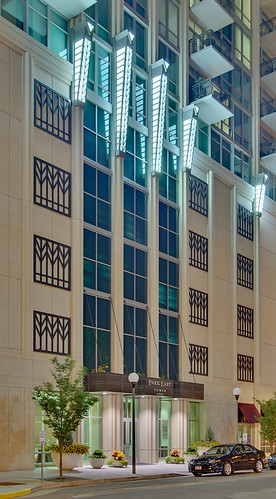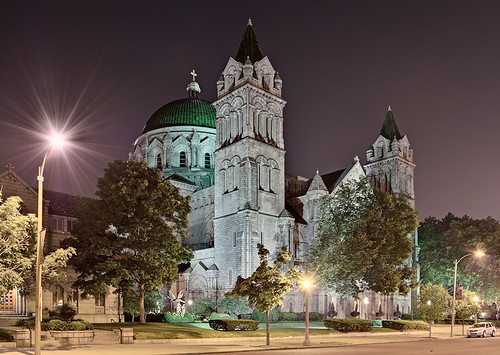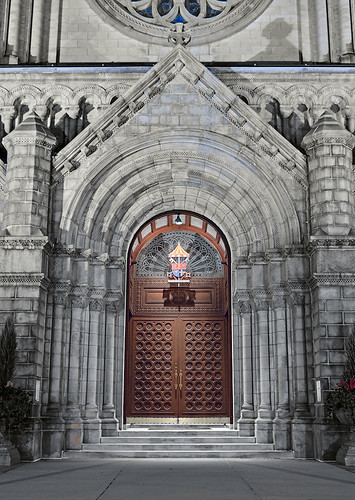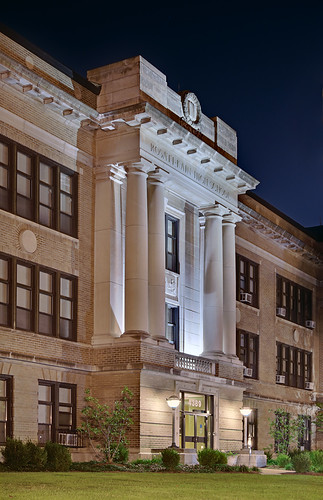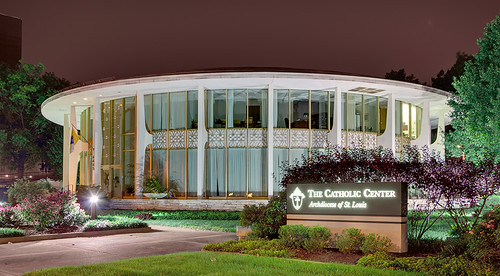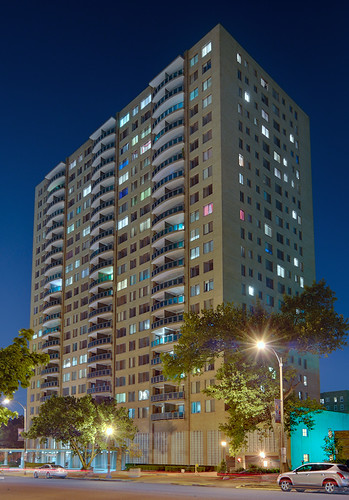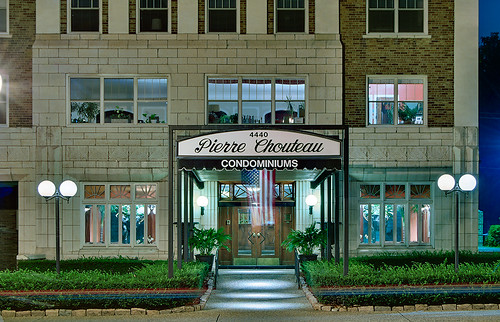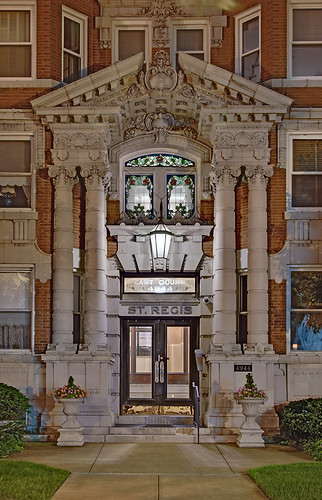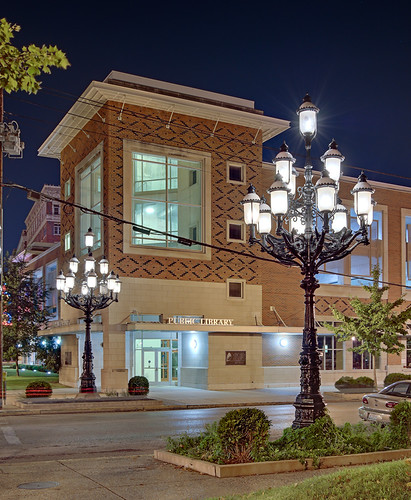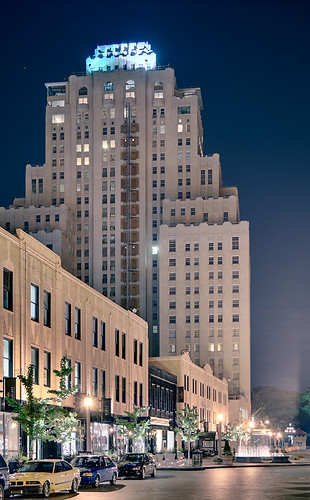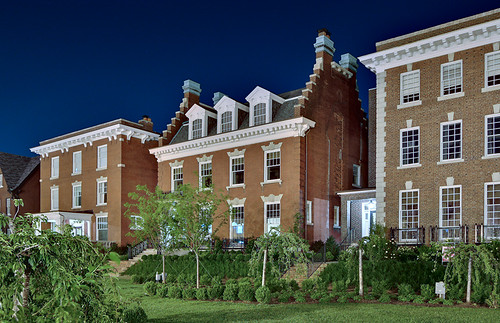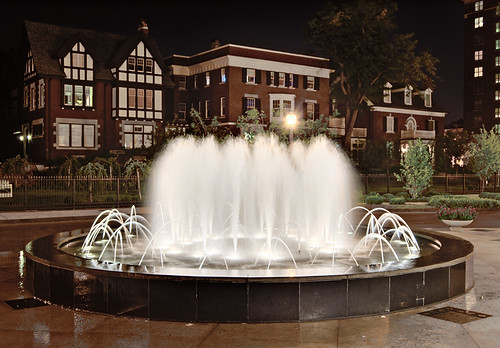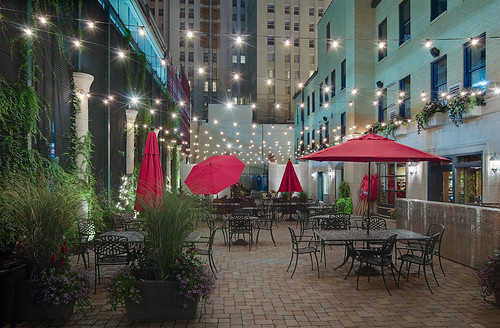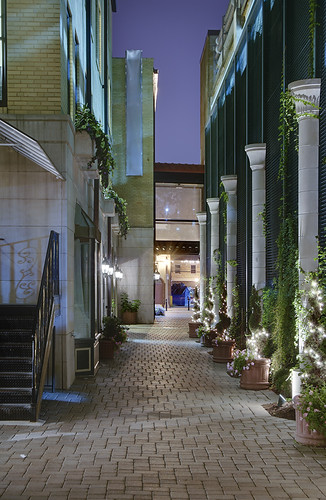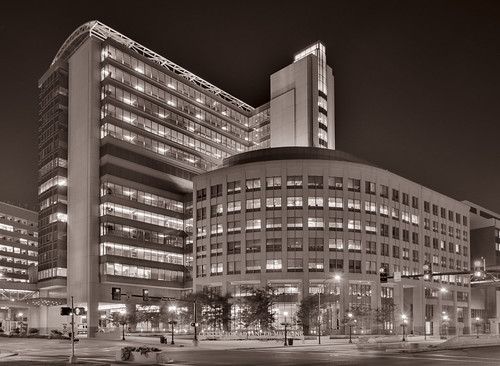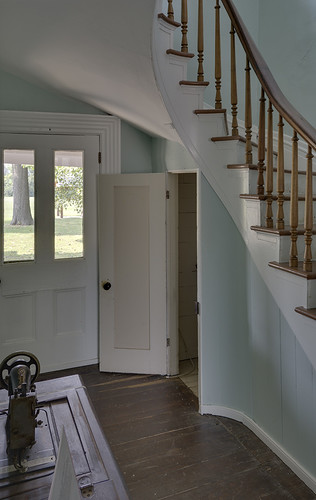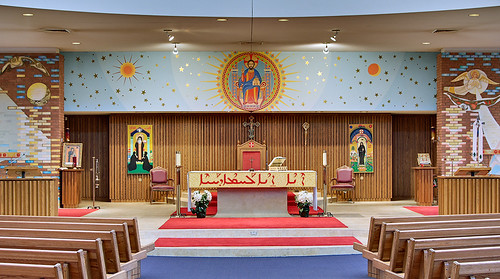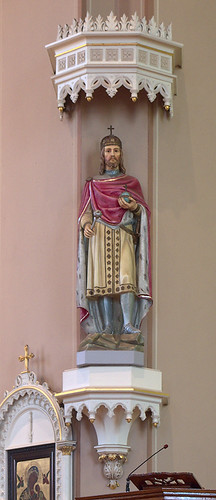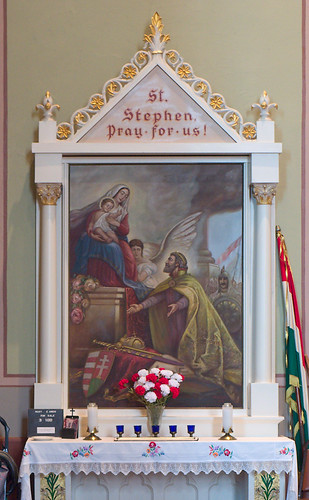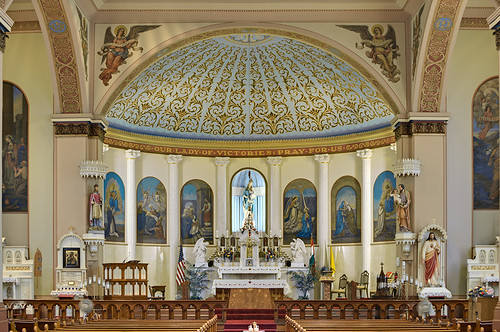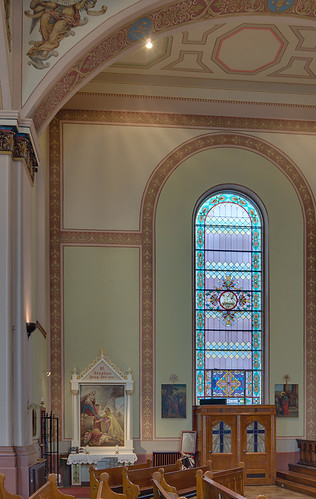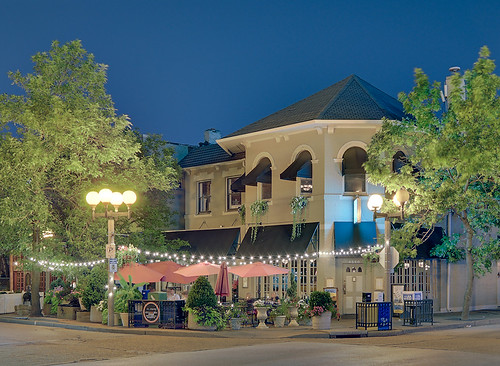
This is one of the most photogenic neighborhoods of the City, and probably one of the wealthiest, although wealth and charm are loosely correlated: consider the attractive yet modest Hill and Soulard neighborhoods, and the middle-income and beautiful Saint Louis Hills area with some of the ugly-but-wealthy new suburbs located far to the west of this area.
Above is an outdoor café in the neighborhood. Outdoor fine dining in Saint Louis did not exist until the 1970s, although beer gardens have existed since the 19th century. These were opened by those who longed for the culinary culture of Europe, even though our hot, humid summers and cold winters militate against this imported idea.
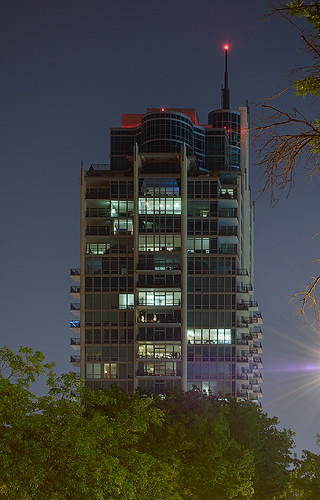
The Park East tower is newly built, and joins the neighborhood's many other high-rise apartment buildings constructed over the past 100 years. And like many of the major historic construction projects in the area, it was for the developer unfortunately completed after the burst of a bubble in real estate prices.
Door of the Park East Tower.
The Central West End tends to be home to urban hipsters, transplanted folks from the East and West coasts, members of old-line Catholic families, and very many medical students and workers. Originally developed in the 1880s, construction of most homes dates from the 1890s to 1910s, with waves of demolition and redevelopment taking place during the booms in the 1920s, 1960s, and the past few years. Much of the northern part of the area consists of private, gated streets, while the southern portion of the area has medical establishments and industry.
The western expansion the city includes the westward motion of the wealthy along the 'central corridor' of the area, which roughly follows the route of Interstate-64/Highway 40 westward into Saint Louis and Saint Charles counties. Mansions along Washington Avenue downtown were destroyed for industry with the occupants moving ever westward, into Midtown, the Central West End, the Debaliviere neighborhood, University City, Clayton, Ladue, Frontenac, Chesterfield, Wildwood, and now Saint Charles County across the Missouri River. Lower income is generally found to the north and south of this axis.
Rootlessness tends to be a problem with our contemporary culture, which always seeks the latest trends, including trends in architectural style and neighborhoods. With globalization, entire countries are ranked according to trendiness, and they are flooded with transient populations who may care little for local culture. The ancient Greco-Roman Stoic idea of the cosmopolis or 'universal city', where all of society is one, is well reflected by this very cosmopolitan neighborhood, which sometimes has less in common with Saint Louis than it has with the elite thinking of the rest of the Western world.
Catholic thinking does agree with the concept of the cosmopolis, but in spiritual and not material matters, and argues instead for stability in local life. Perhaps this is why historic Catholic neighborhoods here tend to be very stable and strong, despite wealth or its lack. When the trendy moved out of the Central West End in the 1960s, the Catholics stayed, and kept the neighborhood afloat until it was restored. Place does matter, and the affection you have for a neighborhood, just because it is familiar and your own, and not because of what it can do for you, is what ultimately keeps neighborhoods alive.
The Park Royal on Lindell Boulevard, dating from 1929; to its right is a new building, completed in 2007.
Many properties in the Central West End, especially on the private streets, have extensive restrictive covenants on their titles.
The concept of restrictive covenants is almost un-American. The concept that a restriction on the use of a property runs with the land and is privately created and enforced, is antithetical to the ideal of unrestricted free markets and to the social ideal that all restrictions and uses come from government. This concept is truly not American, but rather is handed down to us from England, where the law ultimately developed in the Medieval courts of equity run by the Catholic bishops. One could have predicted that problems would have occurred when this concept is implemented by a nation like the United States, which has a poor conception or outright rejection of the Natural Law.
But restrictive covenants, used wisely, help keep a neighborhood stable against the arbitrary plans of a wealthy property developer or the tyranny of government; in short, they keep power and influence very local; they can be abused, but only if those who make and enforce the covenant lack virtue.
There is only one Catholic church in the neighborhood, but that church happens to be the Cathedral Basilica of Saint Louis, which sees strong support from families who have lived in the neighborhood for generations.
Nearby parishes include Saint Francis Xavier to the east, and Saint Roch to the west.
Saint Nicholas Greek Orthodox Church is in the middle of the Central West End, and holds its popular annual festival during Labor Day weekend. Protestant denominations in the area seem weak or absent, with the bulk of the population being either Catholic or heathen.
Cathedral door, surmounted by a coat of arms indicating that this church has been named a minor basilica by the Pope.
Rosati-Kain High School is next door to the Cathedral, and is an Archdiocesan preparatory girl's school, founded in 1911. A boy's prep school, Saint Louis University High School, is run by the Jesuits and is located near the neighborhood.
Chancery offices of the Archdiocese are in this circular building, dating from 1961. This is an ecclesial building in the modern style, but of a lavish quality not seen since the Second Vatican Council.
Curiously, there is another similar round building just down the street, owned by the Automobile Association of Missouri. Click here for an informative and opinionated architectural photo tour of Lindell Boulevard. Construction data on these buildings can be found at Emporis.
A bit of Miami, Florida architecture is found at the Towne House, completed in 1965. But instead of a view of the ocean, this has a view of the Cathedral, which is best seen or photographed from one of these balconies.
Geographically, the Central West End is on level ground, making it eminently walkable and constructible, and was safely above the formerly flood-prone River des Peres, now underground, which used to flow to the immediate west in Forest Park.
The Pierre Chouteau Condominiums, dating from 1929, is named either after an early settler of Saint Louis, son of founder Pierre Laclède and half-brother of co-founder René Auguste Chouteau, or perhaps after his son, Pierre Jr., both of whom were prominent in the fur trade and the expansion of the nation westward.
Nowadays, political correctness has made the use of names of dead, white, European males — involved in colonization and the founding of the nation — almost unthinkable. While some of these these may have been scoundrels, the more recent trend in the City of naming things after living politicians and celebrities has proven even more embarrassing, for these too are often discovered to be scoundrels. This is one reason why Catholics name things after Saints - they have been already vetted for virtue.
Many contemporary names of things are now either boring or arbitrary, saying nothing true and specific. Several buildings on this street are named after their street address, which seems to be rather timid.
The St. Regis Apartments, constructed in 1903. This could be named after Saint John Regis, S.J. (1597 - 1640), or after the St. Regis Indian tribe of New York, or perhaps the St. Regis Hotel in New York City.
At the corner of Lindell Boulevard and Euclid Avenue, decorated with antique light stands, is the Schlafly branch of the Saint Louis Public Library.
Lindell Boulevard is named after Peter Lindell, a merchandiser and landowner in midtown. Euclid Avenue is named after a street of that name in Cleveland, Ohio, which in turn was named after the Greek geometer Euclid. The Schlaflys are a well-known Catholic family in the region, which includes Phyllis the political activist and Tom the brewer.
Maryland Plaza, with buildings from 1935 (foreground), recently redeveloped, and the high-rise Park Plaza Apartments, from 1931.
Stately former mansions on the north side of Maryland Avenue were for a while commercial offices and are now condominiums. Originally, a tall wall, now demolished, separated these homes from the street.
"White flight" due to racism is often cited as the reason for the decay of urban neighborhoods like this one, but the cause is more complicated. In the post-World War II era, the fear of nuclear war with the Soviet Union led to government policies to disperse dense urban populations into far-flung suburbs, and like many Cold War policies, it was implemented in an indirect manner. Simultaneously, other government policies led to the concentration of the urban poor into squalid high-rise developments in the urban core, along with the widespread destruction of their historic neighborhoods for the sake of "green space", leaving tremendous areas of the City empty to this day, lacking an economy, a tax base, as well as the widespread closure and destruction of large numbers of Catholic churches.
People were also driven out of the city. A new breed of politician, with the revolutionary fervor of 1968, told certain kinds of folks that they were no longer welcome, a trend which occurred nationally with the most destructive example being Detroit, Michigan. To this day, the City Fathers are intent on growing the childless urban hipster population, who will keep them in office and pay high taxes, while having little concern for traditional families. The public schools of Saint Louis seem to be intentionally awful, ensuring that conservative Republican middle-class Protestants with families will never live here.
For a while in the 1960s and 1970s, large homes such as these could have been purchased for a bargain, but now are again worth a fortune. Specifically it was high energy prices in the 1970s that caused these homes to lose tremendous value: utility bills could easily reach a thousand dollars per month. But it was the "urban pioneers" who rescued these buildings from destruction, using their own labor to renovate them and make them more efficient. Grand mansions, three stories tall, and once the locale of large families and lavish parties in their ballrooms, are now largely occupied by childless couples.
The buildings shown above face this fountain, which dances. Turn the camera around....
...and you see this alleyway, recently redeveloped, which leads to...
...another outdoor café, closed for the evening. Turning the camera around...
...shows another alleyway, with shops on the left and nice vegetation to the right.
The Chase-Park Plaza is a famous old hotel and apartment complex. The Chase was developed in 1922 by Chase Ullman, who named the hotel after himself. For a while, this was the greatest hotel in the City, then falling on hard times, but has since been renovated several times and has returned to vibrancy. The adjacent Park Plaza was seen in a previous photo.
A blurry outline of a car can be seen here due to the very long camera exposure time.
As the sky grows darker, the ugly sodium vapor lighting from the street makes color photography difficult. Here is the marquee of the Chase's theater, seen in glorious black and white.
Barnes-Jewish Hospital is the major employer in the neighborhood. The Center for Advanced Medicine dates from 2001, and is a part of Washington University's ever-growing medical campus.

